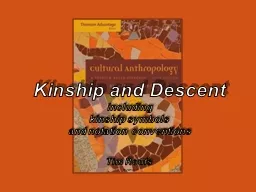

2010 Kinship and Descent including kinship symbols and notation conventions Louis Henry Morgan The Beaver Iroquois Robertson Wisconsin Chippewa Sir EB Tylor Survivals ID: 246638
Download Presentation The PPT/PDF document "Tim Roufs" is the property of its rightful owner. Permission is granted to download and print the materials on this web site for personal, non-commercial use only, and to display it on your personal computer provided you do not modify the materials and that you retain all copyright notices contained in the materials. By downloading content from our website, you accept the terms of this agreement.
Slide1
Tim Roufs
© 2010
Kinship and Descent
including
kinship symbols
and notation conventionsSlide2
Louis Henry Morgan
The Beaver. . . .
Iroquois
Robertson
Wisconsin Chippewa
Sir E.B.
Tylor
“Survivals”Slide3
http://en.wikipedia.org/wiki/Louis_Henry_MorganSlide4
http://www.marxists.org/reference/archive/morgan-lewis/ancient-society/Slide5
Ancient Society
Influence on Marxism . . .Slide6
Louis Henry Morgan
The Beaver. . . .
Franz Boas
The Color of Seawater
Bronislaw
Malinowski
Mathematics and Physical Science
W.H.R. Rivers
M.D.Slide7
Systems of Consanguinity and Affinity in the Human Family
Ancient Society
Louis Henry MorganSlide8Slide9Slide10Slide11Slide12Slide13
http://www.anthro.ucdavis.edu/winterweb/html/UCD_classes/128/fox1.htmSlide14
terms of address
(what you call a relative: “Aunt Helen”)
terms of reference
(how you refer to a relative: “
m
y Aunt”)
descriptive terms
(used by anthropologist: “
MoSi
” / “
FaSi
”) Slide15
terms of address
(what you call a relative: “Aunt Helen”)
terms of reference
(how you refer to a relative: “
m
y Aunt”)
descriptive terms
(used by anthropologist:
“
MoSi
” / “
FaSi
”
)
(used by anthropologist:
“
MoZ
” / “
FrZ
”
)
Slide16
terms of address
(what you call a relative: “Aunt Helen”)
terms of reference
(how you refer to a relative: “
m
y Aunt”)
descriptive terms
(used by anthropologist:
“Cross Cousin”
)
(used by anthropologist:
“Parallel Cousin”
)
Slide17
http://en.wikipedia.org/wiki/Dravidian_kinship#Discovery_of_Dravidian_kinship_terminologySlide18Slide19
these are kinship
systems
and system diagramsnot family trees or genealogiesSlide20
http://www.oup.com/uk/orc/bin/9780198564942/resources/celebres/ch12/
e.g. British Monarchs’ family tree
Queen Victoria to presentSlide21
http://www.oup.com/uk/orc/bin/9780198564942/resources/celebres/ch12/
not kinshipSlide22
http://www.oup.com/uk/orc/bin/9780198564942/resources/celebres/ch12/
Genealogy
traces individuals
in specific familiesSlide23
http://www.britroyals.com/
GenealogySlide24
http://www.britroyals.com/
sometimes referred to as
kindred(distant and close relatives)Slide25
http://www.sciencecases.org/hemo/hemo.asp
Genealogy
Medical Studies tracing inheritance of hemophiliaSlide26
not kinshipSlide27
not kinshipSlide28
Kinship SystemsSlide29
Kinship SystemsSlide30
http://anthro.palomar.edu/kinship/kinship_6.htm
Kinship SystemsSlide31
http://anthro.palomar.edu/kinship/kinship_6.htmSlide32
http://en.wikipedia.org/wiki/Eskimo_kinshipSlide33Slide34
http://anthro.palomar.edu/kinship/kinship_6.htmSlide35
http://en.wikipedia.org/wiki/Eskimo_kinshipSlide36
English Kin Terms -- Brian Schwimmer
Yanomamó Kin Terms -- Brian Schwimmer
Yanomamo and English Terms ComparedAccording to Kin Type Kin TermKin Type
English Term
Haya
F
Father
FB
Uncle
Soaya
MB
Eiwa
B
Brother
FBS
Cousin
MZS
Soriwa
FZS
MBS
WB
Brother-in-Law
ZH
Teeya
S
Son
BS
Nephew
Tataya
ZSSlide37Slide38
http://anthro.palomar.edu/kinship/kinship_6.htmSlide39
http://anthro.palomar.edu/kinship/kinship_6.htmSlide40
http://anthro.palomar.edu/kinship/kinship_6.htm
= brother / sister
= cousinsSlide41
http://anthro.palomar.edu/kinship/kinship_6.htmSlide42
http://anthro.palomar.edu/kinship/kinship_6.htmSlide43
http://en.wikipedia.org/wiki/Iroquois_kinshipSlide44
Source: Ernest L.
Schusky, Manual for Kinship Analysis, 2nd ed. NY: Holt, Rinehart and Winston, 1972, p. 22.Slide45Slide46
http://en.wikipedia.org/wiki/Cross_cousinSlide47Slide48Slide49
Yanomamo and English Terms Compared
According to Kin Type Kin Term
Kin TypeEnglish TermHayaF
Father
FB
Uncle
Soaya
MB
Eiwa
B
Brother
FBS
Cousin
MZS
Soriwa
FZS
MBS
WB
Brother-in-Law
ZH
Teeya
S
Son
BS
Nephew
Tataya
ZS
Source:
Lizot
1971
Slide50Slide51
http://anthro.palomar.edu/kinship/kinship_6.htmSlide52
http://en.wikipedia.org/wiki/Hawaiian_kinshipSlide53Slide54
Matrilineal KinshipSlide55
http://anthro.palomar.edu/kinship/kinship_6.htm
REM:Slide56
http://anthro.palomar.edu/kinship/kinship_6.htm
Matrilineal KinshipSlide57
http://anthro.palomar.edu/kinship/kinship_6.htmSlide58
http://www.umanitoba.ca/faculties/arts/anthropology/tutor/descent/unilineal/patri01.html
Matrilineal (uterine)
descentSlide59
http://www.anthro.ucdavis.edu/winterweb/html/UCD_classes/128/fox1.htm
A
matrilineageSlide60
http://www.anthro.ucdavis.edu/winterweb/html/UCD_classes/128/fox1.htm
Matrilineal, matri- or uxori
-localmatrilocalSlide61
"
postmarital"
residence patternsmatrilocal (locale of the woman's matrilineage)
patri
local
(locale of the man’s
patrilineage
)
uxori
local
(locale of the woman's parents)
viri
local
(locale of the man's parents)
ambi
local
(locale of either woman’s or man’s parents)
[aka
bi
local
]
neo
local
(independent establishment of residence)Slide62
"
postmarital"
residence patternsmatrilocality (locale of the woman's
matrilineage
)
patri
local
ity
(locale of the man’s
patrilineage
)
uxori
local
ity (locale of the woman's parents)
viri
local
ity
(locale of the man's parents)
ambi
local
ity
(locale of either woman’s or man’s parents)
[aka
bi
local
ity
]
neo
local
ity
(independent establishment of residence)Slide63
kinship related suffixes
-
lineal(line of descent)-local(place of “postmarital” residence)
-
lateral
(behavioral bias toward)
-
focal
(cultural hub)
-
archy
(who “rules”)Slide64
kinship related suffixes
matri
--lineal(line of descent)matri--local(place of “
postmarital
” residence)
matri
--
lateral
(behavioral bias toward)
matri
--
focal
(cultural hub)
matri
--archy
(who “rules”)Slide65
kinship related suffixes
patri
--lineal(line of descent)patri--local(place of “
postmarital
” residence)
patri
--
lateral
(behavioral bias toward)
patri
--
focal
(cultural hub)
patri
--archy
(who “rules”)Slide66
"
postmarital"
residence patternsmatrilocalpatrilocaluxorilocal
virilocal
ambilocal
(
bilocal
)
neolocalSlide67
http://www.anthro.ucdavis.edu/winterweb/html/UCD_classes/128/fox1.htm
Matrilineal, matri- or
uxori-localmatrilocalSlide68
http://www.boulder.net/~gillman/anthpaper/anthpap.htmlSlide69
http://www.boulder.net/~gillman/anthpaper/anthpap.htmlSlide70
http://en.wikipedia.org/wiki/Crow_kinship
Matrilineal KinshipSlide71
Matrilineal KinshipSlide72
Patrilineal KinshipSlide73
http://anthro.palomar.edu/kinship/kinship_6.htm
Patrilineage
MatrilineageSlide74Slide75
Patrilineal KinshipSlide76
http://anthro.palomar.edu/kinship/kinship_6.htm
Patrilineal KinshipSlide77
http://anthro.palomar.edu/kinship/kinship_6.htm
Patrilineal KinshipSlide78
http://www.umanitoba.ca/faculties/arts/anthropology/tutor/descent/unilineal/patri01.html
Patrilineal (agnatic)
descentSlide79
http://www.umanitoba.ca/faculties/arts/anthropology/tutor/descent/unilineal/patri01.html
Matrilineal (uterine) descentSlide80
http://www.umanitoba.ca/faculties/arts/anthropology/tutor/descent/unilineal/patri01.html
Patrilineal (agnatic)
descentMatrilineal (uterine) descentSlide81
http://www.anthro.ucdavis.edu/winterweb/html/UCD_classes/128/fox1.htm
A patrilineageSlide82
http://www.anthro.ucdavis.edu/winterweb/html/UCD_classes/128/fox1.htm
patrilineal, patrilocal
patrilocalSlide83
http://www.umanitoba.ca/faculties/arts/anthropology/tutor/descent/unilineal/patri01.html
Descent ruleNumber
PercentagePatrilineal10560%
Matrilineal
52
30%
Dual
18
10%
Total
175
100%
Incidence of Descent Rules among
Unilineal
Societies
Source:
Murdock 1949:59
.Slide84
http://anthro.palomar.edu/kinship/kinship_6.htmSlide85
http://anthro.palomar.edu/kinship/kinship_6.htm
Patrilineage
MatrilineageSlide86
http://en.wikipedia.org/wiki/Omaha_kinship
Patrilineal KinshipSlide87
http://en.wikipedia.org/wiki/Crow_kinship
Matrilineal KinshipSlide88
English Term
Kin TypeDani Term
FatherFOpaije Uncle
FB
MB
Ami
Cousin
MBS
FBS
Oe
MZS
Brother
B
Cousin
FZS
Ejak
Nephew
ZS
BS
Abut
Son
S
Dani
Kin Terms
-- Brian
SchwimmerSlide89Slide90
http://anthro.palomar.edu/kinship/kinship_6.htmSlide91
Kinterm
KintypeBaba
FKardeshBOkul
S
Emme
FB
Dayi
MB
Emme Okul
FBS
Dayi Okul
MBS
Yiken
BS, ZS
Turkish Kin terms Designated by Kin Types
Male Terms Only
Turkish kin terms
--
Brian
Schwimmer
Slide92
Modern English
Kin TypeOld English
FatherFFaederMotherMModor
Uncle
FB
Faedera
MB
Eam
Aunt
FS
Fathu
MS
Modrige
Old English kin terms
--
Brian
SchwimmerSlide93
Tim Roufs
© 2010
Kinship and Descent
including
kinship symbols
and notation conventionsSlide94Slide95Slide96